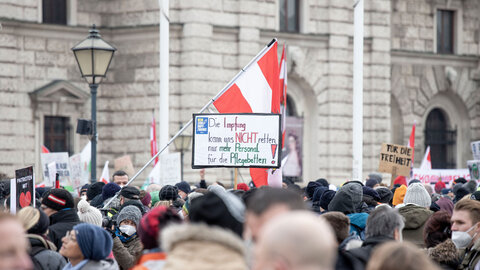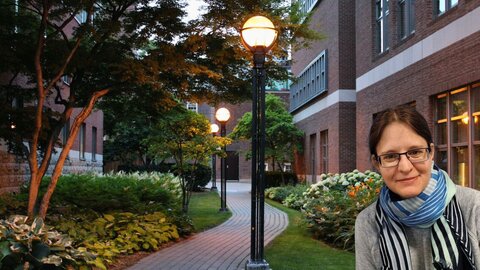More support for risk-takers

For the biologist Ingo Grunwald, it was a barnacle with enormous adhesive power that aroused his curiosity as a researcher at the Fraunhofer Institute. Grunwald came upon the tiny creature quite accidentally during a holiday by the North Sea. Financing from international funding bodies, among them the Austrian Science Fund FWF, finally enabled an interdisciplinary group of researchers to devote their attention to this hitherto neglected crustacean to find out how it produces its “superglue”. The substance could become a promising candidate for medical and technical applications, wherever waterproof, insulating material is needed. When the contemporary historian Dirk Rupnow started to focus his research on the history of migration at the University of Innsbruck in 2015, he not only added a new chapter to Austrian historiography but also became a trailblazer in his discipline. Rupnow was the first to focus comprehensively on the history of the migrant workers (or “guest workers”, as they were called at the time) who came to Austria in the 1960s and 70s and thereby transformed it into an immigration country even back then. The fact that upwards of a million people fled to Europe in that very same year of 2015 was pure coincidence. Migration research will explore the impact of such formative events on society for years to come. It is important for collective memory to capture and process such events, as only then can one understand, categorize and accept complex phenomena. At the Austrian Research Institute for Artificial Intelligence (OFAI), robots are taught to behave like human beings. On the basis of enormous amounts of data, computers learn to boost their knowledge autonomously without human input. While one cannot predict today whether such experiments will prove successful or whether they will ever be translated into practical applications, they obviously have high innovative potential.
Nothing new without basic research
All of the researchers mentioned here are able to carry out curiosity-driven basic research thanks to support from the public sector. The focus is on new findings, insights or eye-openers which may challenge existing knowledge and open up new horizons in the quest for answers. For this, researchers require three things: elbow-room , time and the necessary resources permitting them to work independently of vested interests. Hundreds of examples underscore that such basic research work is indispensable despite the uncertainty of its outcome. The spectrum of examples is huge, ranging from the accidental discovery of penicillin and the development of the Internet to space research, which has given us technologies such as GPS and digital cameras. “Without basic research, there would be no evolution in applications,” says Brigitte Krenn, computer scientist and researcher at the OFAI.
Mitigate scientific risk
While not risk-free by its very nature, basic research thus constitutes a prerequisite for development and innovation. The Austrian Science Fund FWF supports researchers from the outset here and offers them the necessary freedom to conduct cutting-edge research. A new FWF funding programme is now intended to further strengthen this guiding principle. As of mid-November 2019, the Austrian scientific community has been invited for the first time to submit ideas for the “1000 Ideas Programme”. The aim is to seize particularly bold ideas that have the potential either to transform existing research domains or to challenge established paradigms in science and research. Being willing to risk failure is an integral part of the programme. This pilot project will have at its disposal around three million euros per annum for a period of three years. With this step, the FWF is responding to the needs of science to have support available at a very early stage and to give courageous researchers the necessary seed funding. At the end of the day, there is a good chance that unconventional ideas will trigger a breakthrough and that new fields of research will emerge from the fresh approaches. Developments in the research and funding system over past decades show that there are good reasons for creating more systematic anchorage for risky research within the funding system. This will make it possible to initiate new ideas alongside major and established research priorities. Although these priorities have proved very useful for the development of high-quality research from an international point of view, there are limitations when it comes to completely new approaches that are at odds with the current notions of science. Bold and highly original ideas have a hard time getting grants even in basic research – the competition is fierce, after all. The microbiologist and current Wittgenstein Award winner Michael Wagner is full of praise for the FWF’s thrust in the direction of more risk through the newly conceived “1000 Ideas Programme”: “That there’s no requirement for prior work is very good, because it really fills a gap.” Incidentally, the Swiss National Science Foundation launched something similar this year dubbed “Spark”.
Support ideas, but which ones?
The question is which ideas should be fostered, especially if the outcome is uncertain? This represents a challenge for reviewers and also exposes the limits of the traditional selection procedure – the so-called peer review – in which expert opinions are sought and specialized committees evaluate the individual projects. Studies show that it is becoming increasingly difficult for reviewers to assess the broad midfield of projects lying between those at the top and bottom of the scale. You might just as well roll the dice, notes German science researcher Stefan Hornbostel in a recent report by the Tagesspiegel on the Experiment! funding programme, about which first evaluation results have just been published. In 2013, the German Volkswagen Foundation launched this pilot project for “exceptionally daring new ideas”. Since 2017, half of the projects have been selected by drawing lots after a preselection process. This is a conceivable approach for high-risk research, although priority should in principle be given to an evaluation of the proposed content. At any rate, the current peer-review process needs to be continuously developed, as the following example shows. In 2018, the FWF received around 2,500 submissions. Several thousand researchers from all over the world assess these top research proposals on a voluntary basis before they are approved or rejected by the FWF Board. The question is what selection criteria should be used if the number of very good applications increases but only part of them can be approved because there is a lack of funds? Consequently, the reviewers need to take into account very minor and subtle differences, and there is a substantial danger of focusing on details that may not be entirely relevant for the outcome of the project. The FWF is increasingly bumping against the ceiling of what is a highly complex assessment system. This leads to two conclusions: institutions must give more recognition to the service rendered by expert reviewers, and considerably greater weight must be accorded to a proposal’s degree of innovation and the applicant’s willingness to take risks.
New funding programme for fresh ideas
With the “1000 Ideas Programme”, the FWF is the first state-financed funding body in the German-speaking world to use a qualified lottery and double-blind selection procedure in seeking an alternative way of handling applications. The focus is placed on the research idea and on providing funding for it. The description of the project idea and its planned implementation must be submitted anonymously, in writing on no more than seven pages. It has to include a self-assessment of the most risky aspects and potential learnings in the event of failure. This is intended to ensure that eligible projects are identified exclusively on the basis of the project idea and the conclusive description of their implementation. Conventional evaluation criteria such as the success of prior publications or the reputation of the researcher do not enter into the equation.
New approaches to the selection procedure
Half of the maximum number of 30 projects that can be funded are selected by lot from a pool that the FWF Board preselects according to strict criteria and which is then evaluated by an interdisciplinary panel of experts. The other half are awarded on the basis of the recommendations of the jury itself. Up to 150,000 euros are available per project. And if a single jury member considers a project to be particularly innovative, but is unable to convince the rest of the panel, he or she can use a wildcard to bring it into the final round. After all, who knows where serendipity will strike? It is important to note that only the very best ideas reach the final round, and lots are drawn only among the finalists. Thus, the selection procedure itself turns into a learning experience for the FWF. Wittgenstein Award winner Michael Wagner welcomes this type of qualified lottery. Being a reviewer himself, he knows that the excellent and the weak proposals are quickly identifiable, but there remains a certain grey area between these two. “In that case it would sometimes be fairer to let luck decide,” says Wagner.
Courage to take more risk is welcomed
At any rate, the desire to leave more room for chance and to have the possibility of following up on unexpected results exists within the scientific community. In the Volkswagen Foundation’s programme alone, every call for submissions gets around 600 proposals in response. A recent survey in Germany shows that 61 percent of those surveyed believe that scientists should be allowed to decide for themselves what they want to research. It seems the time is ripe for funding bodies to go down new paths when it comes to their evaluation and selection processes for certain areas such as high-risk research and seed funding. The selection hurdle must remain very high, but then there should be the greatest possible freedom of action. There has never been as much knowledge on hand as today, and yet society faces many unresolved questions. “We live in a time when it is becoming more difficult to discover something completely new,” affirms Helga Nowotny in the daily Der Standard upon the publication of her book The Cunning of Uncertainty, in which this expert of science and technology studies and former President of the European Research Council explores the facets of risk and serendipity. Obviously, risk takers have better chances of new insights, and failure allows one to learn from the mistakes – even from the mistakes of others. Science could benefit enormously from the sharing of such data, indeed also where the results appear to be negative.
Further reading > 1000 Ideas Programme > Call for Proposals for Unconventional Research Ideas Started > Science barometer





